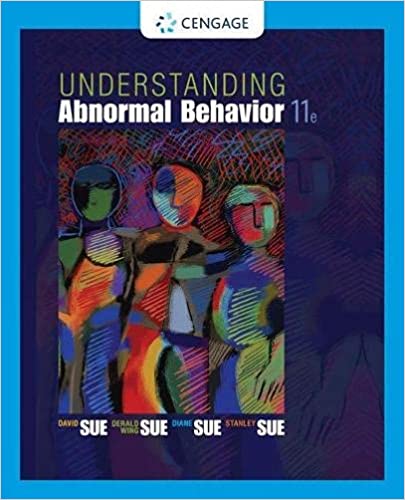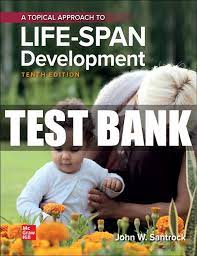Description
Understanding Abnormal Behavior 11th Edition by David Sue – Test Bank
|
Multiple Choice |
|
1. A clinician has collected data about a client based on observations, interview material, and psychological test results. As a first step in the treatment process, the clinician will evaluate this information and formulate a(n) ____. a. psychodiagnosis b. therapeutic plan c. model d. assessment instrument ANSWER: a REFERENCES: Introduction LEARNING OBJECTIVES: UABB.SUES.16.3.1 – Explain how psychological tests and evaluation procedures are evaluated for accuracy. OTHER: Factual |
|
2. Which statement about psychodiagnosis is accurate? a. It involves describing and drawing inferences about a person’s psychological state. b. It is the basis of all research on psychological disorders. c. It includes physical or biological causes for symptoms. d. It is the last step in the treatment process. ANSWER: a REFERENCES: Introduction LEARNING OBJECTIVES: UABB.SUES.16.3.1 – Explain how psychological tests and evaluation procedures are evaluated for accuracy. OTHER: Factual |
|
3. A ____ provides therapists with distinct categories, indicators, and nomenclature for different patterns of behavior, thought processes, and emotional disturbances. a. psychodiagnosis b. psychometric examination c. classification system d. diagnosis ANSWER: c REFERENCES: Diagnosing Mental Disorders LEARNING OBJECTIVES: UABB.SUES.16.3.3 – Explain how professionals make a psychiatric diagnosis. OTHER: Factual |
|
4. A psychologist gives the same test to a client twice. The tests are separated by six days. If the test results are quite dissimilar, we could say that the test has weak ____. a. test-retest reliability b. interrater reliability c. internal consistency d. predictive validity ANSWER: a REFERENCES: Reliability and Validity LEARNING OBJECTIVES: UABB.SUES.16.3.1 – Explain how psychological tests and evaluation procedures are evaluated for accuracy. OTHER: Conceptual |
|
5. Professor Wapner wants to develop a new psychometric test of anxiety. He must be careful to have the various items on the test yield similar results to ensure that it will be high in ____. a. interrater reliability b. test-retest reliability c. construct validity d. internal consistency ANSWER: d REFERENCES: Reliability and Validity LEARNING OBJECTIVES: UABB.SUES.16.3.1 – Explain how psychological tests and evaluation procedures are evaluated for accuracy. OTHER: Applied |
|
6. Dr. Frederick is developing a new test for binge eating disorders. She finds that people who score high on the test engage in more binge eating and other forms of abnormal eating behaviors than people who score low on the test. These results indicate that the test has ____. a. good content validity b. interrater reliability c. high test-retest reliability d. good internal consistency ANSWER: a REFERENCES: Reliability and Validity LEARNING OBJECTIVES: UABB.SUES.16.3.1 – Explain how psychological tests and evaluation procedures are evaluated for accuracy. OTHER: Applied |
|
7. Which assessment best illustrates the concept of reliability? a. A test that measures depression and appears to have items that cover the spectrum of symptoms for depression b. A test that measures counselor aptitude that, when given to prospective counselors, accurately predicts those who will and those who will not perform well in a counseling vocation c. A test that measures attention-deficit hyperactivity disorder and accurately identifies children who currently have difficulty in the classroom d. A test that measures disordered eating behaviors and attitudes that yields similar scores when completed two weeks apart ANSWER: d REFERENCES: Reliability and Validity LEARNING OBJECTIVES: UABB.SUES.16.3.1 – Explain how psychological tests and evaluation procedures are evaluated for accuracy. OTHER: Conceptual |
|
8. A psychologist wants to assess the construct validity of a new test. He can do so by showing that ____. a. scores at Time 1 predict behavior at Time 2 b. all portions of the test produce similar results c. the test results for a group correlate with related measures of a phenomenon d. scores on the test are consistent over time ANSWER: c REFERENCES: Reliability and Validity LEARNING OBJECTIVES: UABB.SUES.16.3.1 – Explain how psychological tests and evaluation procedures are evaluated for accuracy. OTHER: Applied |
|
9. What is the best description of assessment? a. Making conclusions based on comprehensive information b. Beginning treatment in order to judge the client’s prognosis c. Making a diagnosis using DSM-5 d. Interviewing, without using psychological tests ANSWER: a REFERENCES: Assessment and Classification of Mental Disorders LEARNING OBJECTIVES: UABB.SUES.16.3.2 – Describe the kinds of tools that clinicians employ in evaluating a client’s mental health. OTHER: Factual |
|
10. Dr. Peterson has collected clinical observations, neurological test data, psychological test scores, and interview material on Mrs. Davis. If Dr. Peterson is doing this for the purpose of drawing conclusions that will lead to a diagnosis of Mrs. Davis, we can infer that Dr. Peterson is ____. a. a psychoanalyst b. using reliable and valid measures c. doing an assessment d. using the DSM-5 ANSWER: c REFERENCES: Assessment and Classification of Mental Disorders LEARNING OBJECTIVES: UABB.SUES.16.3.2 – Describe the kinds of tools that clinicians employ in evaluating a client’s mental health. OTHER: Applied |
|
11. Dr. Simon is observing several schizophrenic patients interact in a mental hospital ward without interfering. Which type of observation is Dr. Simon using? a. diagnostic b. naturalistic c. analogue d. controlled ANSWER: b REFERENCES: Assessment and Classification of Mental Disorders LEARNING OBJECTIVES: UABB.SUES.16.3.2 – Describe the kinds of tools that clinicians employ in evaluating a client’s mental health. OTHER: Applied |
|
12. Gathering information on brain structures focuses on which type of assessment? a. psychological tests b. neurological tests c. interviews d. observations ANSWER: b REFERENCES: Assessment and Classification of Mental Disorders LEARNING OBJECTIVES: UABB.SUES.16.3.2 – Describe the kinds of tools that clinicians employ in evaluating a client’s mental health. OTHER: Factual |
|
13. A psychologist notices that a male client rarely makes eye contact and pulls at his ear when he seems nervous. What type of assessment is the psychologist performing? a. observation b. projective testing c. structured interviewing d. controlled testing ANSWER: a REFERENCES: Assessment and Classification of Mental Disorders LEARNING OBJECTIVES: UABB.SUES.16.3.2 – Describe the kinds of tools that clinicians employ in evaluating a client’s mental health. OTHER: Applied |
|
14. When Dr. Wilson administers psychological tests, she strictly follows specific procedures. This refers to what aspect of test administration? a. reliability b. validity c. norming d. standardization ANSWER: d REFERENCES: Reliability and Validity LEARNING OBJECTIVES: UABB.SUES.16.3.1 – Explain how psychological tests and evaluation procedures are evaluated for accuracy. OTHER: Applied |
|
15. A psychologist notes that a female client is wearing a heavy wool sweater and cap on a hot summer day. The client walks with a limp and mumbles to herself. The psychologist should ____. a. interpret these objective signs without regard to the individual’s culture b. conduct testing or interviewing and disregard the information about the client’s appearance c. assess the diagnostic significance of these observations with interview and other information d. disregard these observations in order to make an unbiased assessment ANSWER: c REFERENCES: Assessment and Classification of Mental Disorders LEARNING OBJECTIVES: UABB.SUES.16.3.2 – Describe the kinds of tools that clinicians employ in evaluating a client’s mental health. OTHER: Applied |





Be the first to review “Understanding Abnormal Behavior 11th Edition by David Sue – Test Bank”